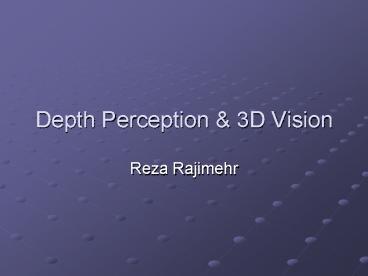Depth Perception - PowerPoint PPT Presentation
1 / 44
Title:
Depth Perception
Description:
Information available in the optic flow is sufficient for the perception (direct ... Diplopia (doubleness) Repeat finger experiment. Stereoblindness in Strabismus, ... – PowerPoint PPT presentation
Number of Views:2100
Avg rating:5.0/5.0
Title: Depth Perception
1
Depth Perception 3D Vision
- Reza Rajimehr
2
3-D Perception Inferential leap from image to
environment
Inverse Problem depth ambiguity
No inverse problem with 3-D retina
3
Reducing the problem
Perceiving distance
- Depth
- Surface orientation Slant and Tilt
Perceiving 3-D objects
4
Surface layout recovering orientation at a
distance
Visible surfaces
5
Theoretical Frameworks
- For solving the inverse problem
6
Ecological optics
- Active exploration of the environment (ecology)
- Information available in the optic flow is
sufficient for the perception (direct
perception), no need for internal representations - Adding temporal dimension to the 2-D optic array
(dynamic optic array) could solve the inverse
problem
Information theory and computer vision
J.J. Gibson
Texture gradient
7
But it is insufficient to solve the problem
uniquely!
8
Heuristic assumptions
Veridical perception vs. Perceptual illusions
Helmholtz
Probabilistic view of perception
Leading to unique interpretation
Solving the inverse problem
9
Computational approaches to ecological optics
Marrs 2.5-D sketch
David Marr
X Modules
10
Sources of depth information -Depth cues
- Ocular information / Optical information
- Binocular information / Monocular information
- Static information / Dynamic information
- Absolute information / Relative information
- Quantitative information / Qualitative information
11
Sources of depth information -Depth cues
- Ocular information
- Stereoscopic information
- Dynamic information
- Pictorial information
12
Accommodation
- Ocular/Monocular/Static/Absolute/Quantitative
- Visual system should have access to the
information about the tension of the muscles - Useful for close distances
- Accommodation is derived by image blur so that
the output of high spatial frequency channels is
maximized - The best depth cue in the African chameleon
13
Convergence
- Ocular/Binocular/Static/Absolute/Quantitative
- Useful for close distances
- Convergence and accommodation are not independent
14
Stereoscopic information
Finger Experiment
- Optical/Binocular/Static/Relative/Quantitative
- Binocular disparity
Direction of disparity Crossed disparity
close Uncrossed disparity far Magnitude of
disparity How much closer or farther
Effective within 30 meters
15
Stereoscopic informationThe Horopter
Also fixation point has zero disparity.
16
Stereoscopic information
Diplopia (doubleness)
Repeat finger experiment
Stereoblindness in Strabismus, also in children
with cataract in one eye
Panums fusional area
17
Stereograms
Crossed convergence method Uncrossed convergence
method
Seeing stereograms with Stereoscope
18
The correspondence problem
19
Random Dot Stereograms
Bela Julesz
However, there may well be some primitive shape
analysis before stereopsis.
20
How to construct RDS?
21
Computational Algorithms for solving the
correspondence problem
e.g. Marr-Poggio, 1977
taking heuristic constraints into account (e.g.
surface opacity and surface continuity)
22
Autostereograms
Christopher Tyler
23
Autostereograms
24
Autostereograms
25
Vertical Disparity
26
Da Vinci Stereopsis
27
Physiological mechanisms of binocular disparity
Recording from V2
- V1 Responds to zero or near-zero disparity
- V2 Responds to large disparities
- (Hubel Wiesel, Barlow Blakemore)
- Recently V3A, V4 and MT
28
Disparity selectivity in area MT
29
fMRI of Stereopsis
30
Binocular Rivalry
Red/Green filter glasses
Convergence method
Mirror devices
31
Dynamic Information
Old depth cues in evolution
- Motion Parallax
Objects closer to you travel at faster speeds and
in the opposite direction further objects travel
slower and in the same direction.
32
Dynamic Information
- Optic flow (optic expansion)
33
Dynamic Information
- Kinetic depth effect (KDE)
Rigidity heuristic
34
Pictorial Information
- Linear perspective
35
Pictorial Information
- Horizon
36
Pictorial Information
- Relative size
- Familiar size
- absolute depth cue
37
Pictorial Information
- Texture gradients
- systematic changes in the shape and size of
texture elements
Notice to the background of slides!
38
Pictorial Information
- Partial occlusion or interposition
39
Junctions
40
Pictorial Information
- Shading
41
Pictorial Information
- Cast shadows
Perceiving the height of objects
42
Pictorial Information
Non-homogeneous textures, 2004
43
Integration/Interaction of different depth cues
Pseudoscope
Cue conflict between disparity and monocular
depth cues
44
- Main Reference
- Vision Science Palmer (Chap 5)

